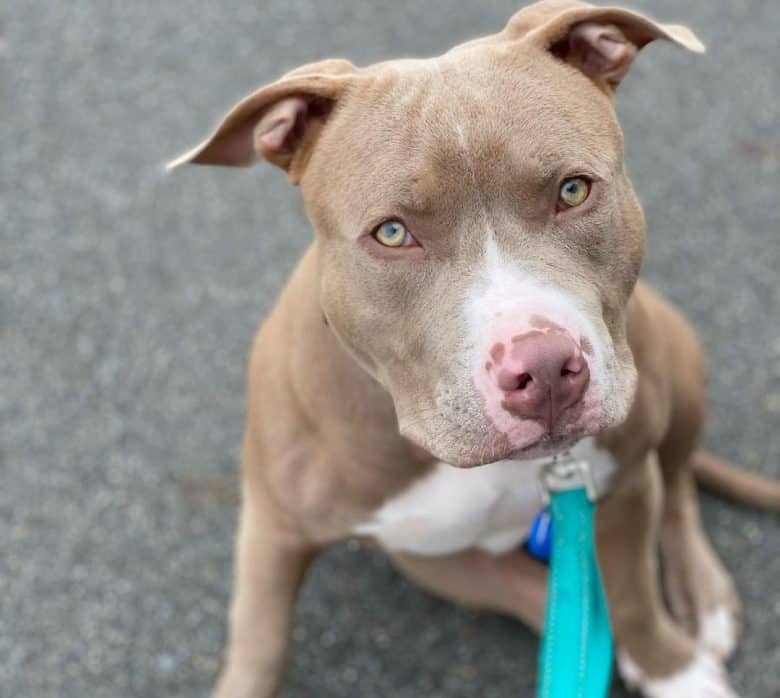Do you want to find the best pet insurance?
Lets analyze your pets breed, age, and location to find the right coverage and the best savings. Ready?
The pet insurance marketplace endorsed by veterinarians, at Pawlicy Advisor we make buying the best pet insurance easier. By comparing personalized coverage and pricing differences we can save you a ton of money, up to 83% in some instances!
Is My Pitbull Growing Properly?
Pitbulls typically stop growing and reach their full adult size between 12 and 18 months. The first 9 to 12 months will be a wonderful time of growth and development for your pup. We’ll provide you with guidelines and averages concerning the height and weight depending on your dog’s age.
However, keep in mind that monitoring healthy physical development isn’t just about rigid numbers. Every dog is different, and it’s essential to consider your dog’s appearance, behavior, and weight. Also, keep in mind that growth isn’t always linear. It’s pretty standard for a dog to have overnight growth spurts followed by periods of plateaus.
Here’s a tip to help judge your dog’s size: look at their paws. Younger dogs will grow into their feet, and bigger dogs will have large paws even as young pups. If your puppy’s paws still seem large in proportion to its body, she probably still has some healthy growing left to do.
Stage Five: 16 to 40 Weeks Old Pitbull (4-10 Months)

As your puppy’s cognitive thinking matures, Pitbull will test your authority more and more. Tug of war and other games that encourage dominance should be avoided.
Staying consistent is crucial but try to use positive reinforcement rather than punishment to foster a healthy relationship with your puppy.
At 4 months old, your Pittie should be 25 – 50 lbs, and males may begin to lift their leg to mark, and females may enter their first heat.
Getting your dog sterilized is an option to prevent any unwanted litter or behavior from forming.
What you Need to Know about Pit Bulls
Are you thinking about adding a pit bull to your family? Owning a pit bull can be a very rewarding experience. From their eager-to-please demeanor to their loyal and affectionate natures, pit bulls capture the hearts of dog owners around the world.
Here are five important considerations to make before deciding if a pit bull is right for your home. Pit bulls come in many packages. The moniker “pit bull” is a category, rather than a breed, and refers to a variety of dog pedigrees. That means pit bulls range in size. Breeds such as American Staffordshire Terrier, Staffordshire Bull Terrier, and Cane Corso mixes weigh in the 30-40 lb. range, while mastiff mixes can weigh well over 100 lbs. As mentioned above, the average pit bull weighs in around 55-60 lbs. With this in mind, it is possible to choose a breed that fits your size requirements. They are all generally strong, tenacious, and loyal dogs who need an owner with experience and one who is ready to lead firmly and with lots of love. Also, some pitt bulls aren’t great multi-pet household dogs; they may object to other dogs or cats. However, this is not a hard-and-fast rule, just something to be aware of.
Many pit bulls are very athletic and have lots of energy to burn. If you think the muscular, sleek appearance of pit bulls indicates superior athleticism, you’re right. Most pit bulls are very athletic and have a lot of energy. If you’re active and love to get outside, pit bulls can make great companions on runs, hikes, swims, and other outdoor activities. Pit bulls are affable and enthusiastic companions. Pit bulls can be especially friendly and enthusiastic. In fact, many tend to act like lap dogs, and average pit bulls weigh between 55 and 60 pounds! This is great, but considering their size, sometimes their vigor can overwhelm very young children and older people. Pit bulls are primarily house dogs. One great aspect of pit bulls is the fact that they have short coats and don’t shed much. Obviously, this is ideal if you aren’t interested in dealing with a house covered in fur. However, it also means that pit bulls are primarily house dogs. Because they don’t fare as well in colder climates compared to fluffier dogs such as Siberian huskies and golden retrievers, they shouldn’t be left outside for extended periods of time. Social Stigma If you’re considering owning a pit bull, you might need to have thick skin. There are several stereotypes about pit bulls that contribute to a substantial social stigma concerning pit bull owners.
Because of these stereotypes, pit bull owners have to deal with a certain level of scrutiny as to the training and control of their pets. What most people see in their pit bulls – loving, cheerful goofballs with lots of disposable energy—is not necessarily what the general public sees. Some social stigmas attached to pit bull owners include:
Pit bulls can be incredibly rewarding pets – just ask their owners! Just make sure that you are fully prepared and informed before you decide to make the leap and add a pit bull to your family.
If you have any questions or concerns, you should always visit or call your veterinarian – they are your best resource to ensure the health and well-being of your pets.